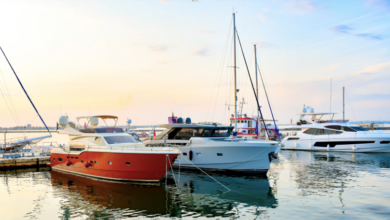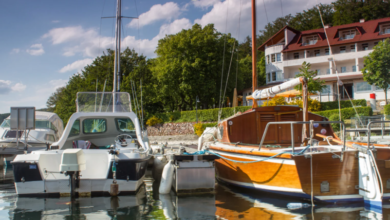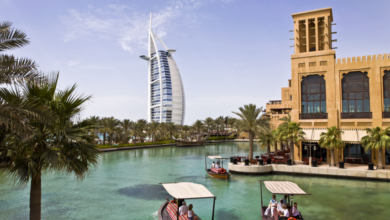
Who Invented the Monorail — From Early Designs to the Modern Palm Monorail in Dubai
Transportation has always reflected humanity’s pursuit of speed, innovation, and efficiency. Among the many inventions that reshaped how we move, few are as visually striking as the monorail — a sleek train gliding on a single track. But who invented the monorail, and how did this futuristic idea become a real-world transport system? The story stretches back to 19th-century England and continues today in Dubai with the Palm Monorail, one of the region’s most distinctive rail systems.
The Early Vision: Henry Palmer’s 1821 Concept
The first spark of monorail innovation came from Henry Palmer, an English engineer who, in 1821, patented a transport design that would revolutionize travel. Palmer’s monorail involved a single rail elevated above the ground, with vehicles hanging beneath. It was powered by horses rather than electricity, but the concept itself was ahead of its time.
By 1824, Palmer’s idea had evolved into the world’s first operational monorail line, and by 1825, it carried passengers — a world first. Soon after, other engineers expanded on his concept:
- Maxwell Dick introduced safety rails to reduce derailment risks.
- William Thorold proposed a monorail design that could run alongside roads, making it a more practical form of urban transit.
These early inventors laid the groundwork for the systems we recognize today — elevated, streamlined, and engineered for modern city life.
See also: <strong>The Traveller’s Essential: Why a Reliable Travel Mug Is Worth Packing
Evolution Through the Decades
Through the 19th and early 20th centuries, the monorail evolved slowly. Steam engines gave way to electric motors, and steel structures replaced wooden frames. However, monorails truly gained attention during the mid-20th century, when cities began exploring futuristic urban transport solutions.
In 1959, Disneyland introduced its own monorail — a sleek, electric train looping through the park. It wasn’t just an attraction; it symbolized the future of transportation. Other cities soon followed, experimenting with elevated monorail networks that could reduce congestion and pollution while offering panoramic views of the cityscape.
Two Main Types: Hanging and Suspended Monorails
Although “monorail” sounds like a single, unified concept, there are actually two main types:
- Hanging Monorail – The train hangs below a single elevated rail, offering excellent stability and smooth travel.
- Suspended Monorail – The train sits atop the rail, supported by pillars or columns.
Both types are built to minimize vibration and noise, making them perfect for urban environments where space and silence are precious. This design flexibility is one reason why monorails have been adopted by so many cities around the world.
Global Adoption: Monorails Around the World
Today, monorails operate in cities and attractions across continents, each with its own unique character and purpose. Some of the most famous include:
- Tokyo Monorail (Japan) – One of the busiest monorails globally, connecting Haneda Airport to central Tokyo.
- Europa Park Monorail (Germany) – A scenic route through one of Europe’s largest theme parks.
- Window on the World (China) – A short, entertaining ride around a theme park filled with global landmarks.
- Sydney Monorail (Australia) – Once a major urban feature, remembered for its futuristic design and city views.
These examples highlight how monorails have gone beyond transportation — becoming part of city identity and tourism appeal.
Monorails in the Middle East
In the MENA region, the monorail remains a developing concept, but Dubai has taken the lead. The Palm Jumeirah Monorail, opened in 2009, stretches over 5.4 kilometers, connecting Gateway Towers on the mainland to the iconic Atlantis Hotel. Elevated above the waters of Palm Jumeirah, it provides stunning skyline views and an effortless commute for tourists and residents alike.
Other regional developments include:
- Egypt’s Cairo Monorail, currently under construction, set to connect the New Administrative Capital with 6th of October City. When completed, it will be one of the longest monorail systems in the world, with over 90 kilometers of track.
- Saudi Arabia has proposed integrating monorails into its Riyadh Metro Project, though none are fully operational yet.
- Qatar and Kuwait have short recreational monorails in entertainment complexes, while Oman has studied similar urban projects.
For now, Dubai’s Palm Monorail remains the region’s only fully operational urban monorail — a symbol of innovation and urban design excellence.
Advantages and Challenges of the Monorail System
Monorails offer several key benefits that explain their global appeal:
Advantages:
- Environmentally friendly and energy-efficient, consuming less power than traditional rail systems.
- Elevated design reduces land use and avoids road traffic, improving city flow.
- Quiet operation and smooth rides enhance passenger comfort.
Challenges:
- High construction and setup costs compared to buses or trams.
- Limited speed due to curved elevated tracks.
- Specialized maintenance and equipment increase operational complexity.
Despite these challenges, cities continue to invest in monorail systems for their long-term efficiency and ability to blend seamlessly into dense urban environments.
In the End
From Henry Palmer’s horse-drawn design in 1821 to Dubai’s sleek Palm Monorail gliding above the sea, the monorail’s story is one of evolution and ingenuity. What began as a bold experiment in England now defines modern transport in some of the world’s most forward-thinking cities. As innovation continues, monorails may soon become even more common — linking communities, reducing congestion, and offering a futuristic yet practical way to move through our ever-growing urban world.




